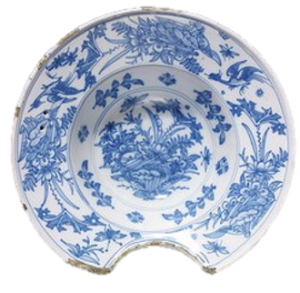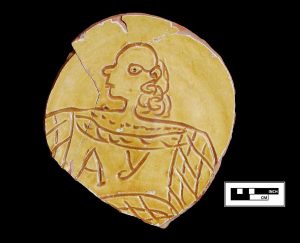North Devon Sgraffito Barber’s Basin from Clifts Plantation Archaeology
North Devon Sgraffito Barber’s Basin from Clifts Plantation Archaeology
By: Ziv Carmi, Stratford Hall Summer 2020 Intern
When whole, this barber’s basin had many functions. These basins had a small indentation in the rim so that the user would be able to comfortably hold the basin against his neck1. They were primarily used by barbers, whom, in this era, commonly also performed basic medical procedures like bloodletting. However, they often were used privately by men who shaved themselves or had their enslaved do it for them. The basin was designed to be all-purpose, to mix and hold soapy water during a shaving and blood during a bloodletting2. Some of these basins were even designed to hold a block of shaving soap for convenience when mixing the lather3. 
This basin was made in the late 17th century in the pottery tradition of Britain’s North Devon region. It is earthenware, fired at a lower temperature so that the clay remains relatively porous, and as such, was often covered in a glaze to make it more impermeable to liquids4. Slip, a mixture of clay and water, was often used to decorate earthenware. Slip was applied beneath a transparent glaze, usually lead sulfide or lead oxide either in a manner akin to decorating a cake (as archaeologist James Deetz puts it) or through the technique of sgraffito5. Sgraffito is when the potter uses a sharp object to cut through the slip, causing the natural color of the clay to become exposed. In the case of these sherds, it is a yellow glaze covering a brown clay body. On the edge of one of the fragments, the slip is peeling, further exposing the clay underneath.
The colorations on our sherds are typical of North Devon sgraffito ware, which commonly has an incised slip decoration of brown motifs on yellow glaze. The earthenware also often has a gray core due to reduced oxygen in the firing process6. This type of pottery has been found in American archaeological sites dating from the 1620s onwards but is most prominent in contexts (the environment in which the artifact is found) dated in the latter half of the 17th century7. Of these 17th century archaeological sites, Devonware sherds are a common find on English colonial sites but rarely found on Spanish sites, meaning that it was exported to and used primarily by English settlers rather than Spaniards8. North Devon Sgraffito usually has either a nautical, commemorative, natural, or agricultural design9. The few sherds of this basin show a man’s profile, with the initials “AY” written on the chest as well as some flourishes, likely used as a decorative motif. The man appears to be wearing a cape reminiscent of the ermine mantles worn in the coronation portraits of Kings William III, George I, and George II. Unfortunately, however, the few details we have are not enough to give concrete answers regarding the full design.
Most North Devon pottery was made primarily in the English towns of Bideford or Barnstaple. Indeed, the pottery tradition at Bideford stretches back to the late medieval era. At the height of the pottery industry in the 17th and early 18thcenturies, hundreds of potters created sgraffitoware in Bideford and the surrounding towns of Instow and Westleigh10. At any given time in the height of the pottery boom, between 1630 and 1690, up to thirty or forty kilns were firing11. The pottery industry further expanded the Bideford economy, taking advantage of its port to export not only across Britain but to Ireland and, of course, the colonies across the Atlantic. While the largest market for pottery was in Ireland, the colonies were a significant market, making up for about 15% of the overseas export of North Devon pottery.12
By the turn of the 18th century, however, North Devon sgraffito fell out of fashion for blue and white wares like delft, which emulated porcelain (a good example of delftware can be seen in the illustration above)13. The primary contributing factor for this was the growing popularity of Asian porcelain as an expensive luxury. Since porcelain was so expensive and popular, cheaper delft goods that looked like porcelain made in Europe were in great demand for those who wanted to flaunt their status affordably. The meaning of the lettering on the barber basin sherd is unknown. While it could possibly be the name of the owner or signature of the potter, it is unlikely that it does. According to C. Malcolm Watkins, former head curator of the Department of Cultural History at the Smithsonian’s National Museum of American History, none of the North Devon wares found on American sites (as of the time of publication of Watkins’ book in 1960) had the initials of the owners or potters on them14. Indeed, a chamber pot, the one piece of North Devon ware found that did have initials on it, is believed by Watkins to be a display of contempt shown towards the Anglican King William III by the largely Puritan potters of Barnstaple and Bideford15. Going by this line of thought, it is possible that the “AY” stands for Queen Anne, who ruled from 1702 to 1707 (especially considering that the figure is wearing a cape that appears similar to a monarch’s coronation robes), it is unlikely that it does since Royal Initials were the name of the monarch followed by “R” for either “Rex” or “Regina”, depending on the gender of the monarch. Both “Rex” and “Regina” are Latin for “reigning leader” and have been a part of the British Monarchy’s cyphers since Henry VIII, so it is unlikely that a potter would deviate from that nomenclature16. Indeed, even in the disrespectful usage of the King’s name on the chamber pot is described by Watkins as “WR”, so, had the maker of the barber basin wanted to refer to Queen Anne, he likely would have inscribed “AR” on it17.
This sherd was dug up during Fraser Neiman’s 1976-1978 excavation of Clifts Plantation. According to Neiman, the site of The Clifts Plantation was purchased by Nathaniel Pope in 165618. While documents show that The Clifts was occupied as a tenant farm starting in 1664, we do not know who these early tenants were19. Nathaniel’s son Thomas, the owner of The Clifts following Nathaniel’s death in 1660, was a merchant who spent much of his time in Bristol trading the tobacco grown on his Virginia property20. Following his death, his widow Joanna managed the plantation from Bristol21. It was she and her sons Richard and Nathaniel who sold it to Thomas Lee in 1717. The archaeological record shows that tenants lived on The Clifts through the early years of Thomas Lee’s ownership until about 173022. Between a 1716 document referring to the main house on The Clifts as a “manner house” and the large size of the house as determined by the archaeological remains, Neiman concluded that the tenants were reasonably wealthy.23
Neiman divided soil layers into four time periods using the presence of certain ceramics to determine terminus post quem, the earliest possible time that the artifact could have been buried in the soil layer. These four time periods consist of four phases: Phase I (1670-1685), Phase II (1685-1705), Phase III (1705-1715), and Phase IV (1720-1730).24 Of the discoveries made in trash pits, 121 total pieces of North Devon sgraffitoware were found. Of these, one is dated from Phase I (.8%), fourteen from Phase II (11.6%), twenty-six from Phase III (21.5%), and eighty from Phase IV (66.1%).25 Indeed, along with these two sherds, nine other pieces of sgraffitoware were dug up in what was the exterior cellar of the manor, indicating that all eleven were thrown away at similar times26. Given the proximity to the manor, it is likely that these sherds were used by the tenants living there. However, Joanna Pope’s letters of attorney show that there was an enslaved population living on the plantation since 1706.26 Broken pottery was often passed down to the enslaved people for their use, so it is possible that the basin was used by the tenants, broke, was given to the enslaved men to use, broke again, this time beyond use, and thus was thrown away.
These sherds were found in a Phase IV trash pit. However, what is exceptionally interesting about this trash pit is that, while it is dated to Phase IV, it contains many sherds that have a style of earlier pottery.27 Using a soil analysis, Neiman concludes that the cellar was filled with nearby topsoil containing many older artifacts.28 This means that trash from the manor house was often dumped in the area prior to the erection of the cellar.29 While it is possible that the discarding of the basin dates to Phase IV, it is likely older than that considering the presence of pre-Phase IV artifacts in the cellar and sgraffito’s fall from style in the late 17th Century.
Archaeology can tell us much about the way people lived in the past. By studying ordinary objects like this barber basin, it is possible to discern cultural trends, economic conditions, and social values, to name a few. In studying the smaller objects that were in someone’s trash pile several hundred years ago, it is possible to reconstruct their way of life today.

Works Cited
Deetz, James. In Small Things Forgotten. New York: Anchor Books, 1996.
Florida Museum. “Slipware, Sgraffito- Type Index.” Accessed May 26. 2020. https://www.floridamuseum.ufl.edu/typeceramics/type/slipware-sgraffito/
Green, Sadie. “Bideford Pottery Trade.” Bideford 500, accessed May 27, 2020. http://www.bidefordheritage.co.uk/research/bideford-pottery-trade/
Jefferson Patterson Park and Museum. “North Devon Sgraffito Earthenware.” Accessed May 26, 2020. https://apps.jefpat.maryland.gov/diagnostic/ColonialCeramics/Colonial%20Ware%20Descriptions/NorthDevonSgraffito.html
Neiman, Fraser D. “Field Archaeology of The Clifts Plantation Site, Westmoreland County, Virginia” (1980).http://colonialencounters.org/files/sitereports/Clifts-2.pdf
Tomlinson, Georgina. “Spotting a Royal Cypher.” The Postal Museum, June 17, 2016. https://www.postalmuseum.org/blog/royal-cypher-appearances/
Victoria and Albert Museum Collections. “Shaving Basin.” Accessed May 27, 2020. http://collections.vam.ac.uk/item/O163107/shaving-basin-unknown/
Watkins, C. Malcolm. “North Devon Pottery and its Export to America in the 17th Century.” United States National Museum Bulletin 225 (1960): 17-59. https://www.gutenberg.org/files/36092/36092-h/36092-h.htm. Project Gutenberg.

